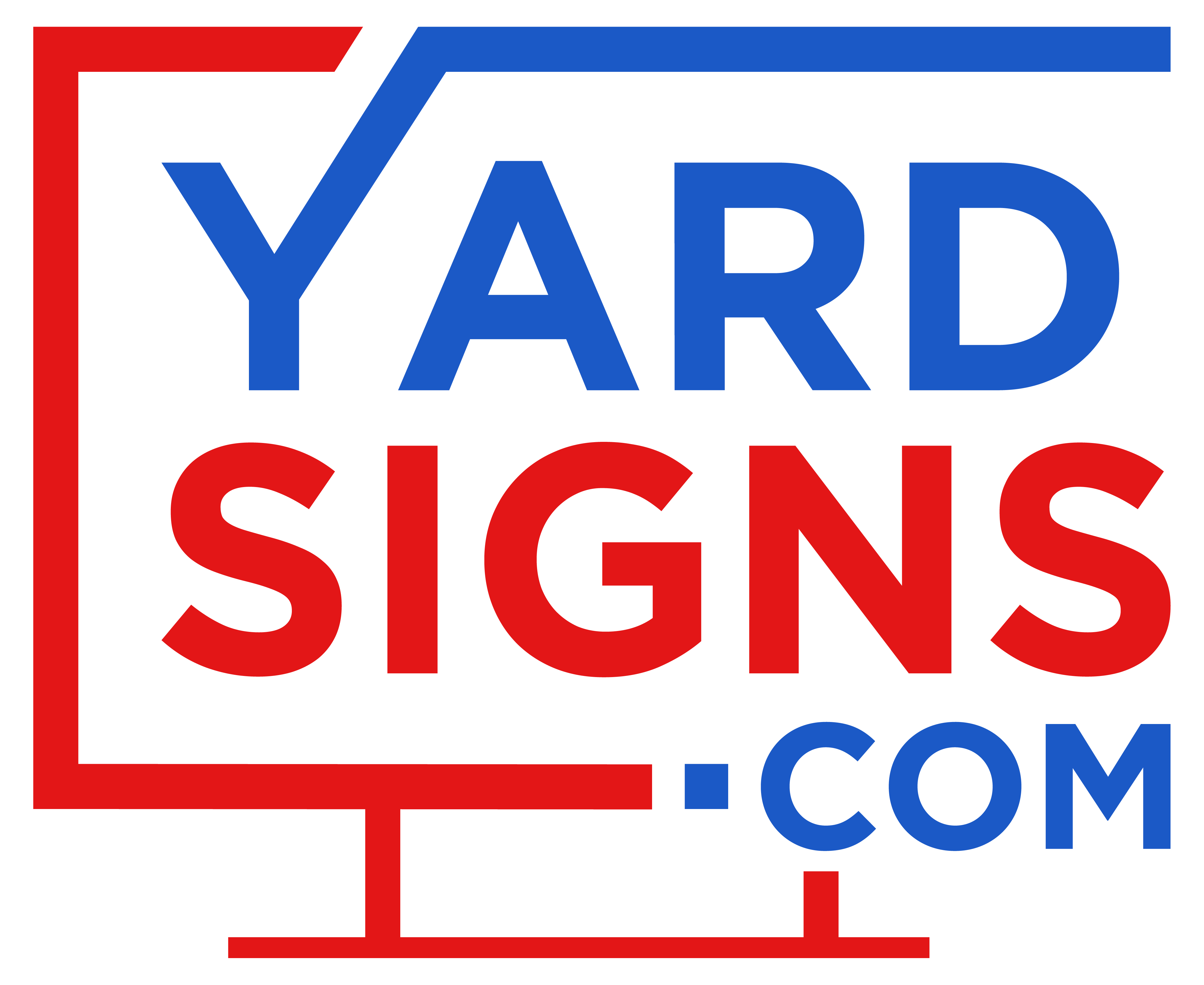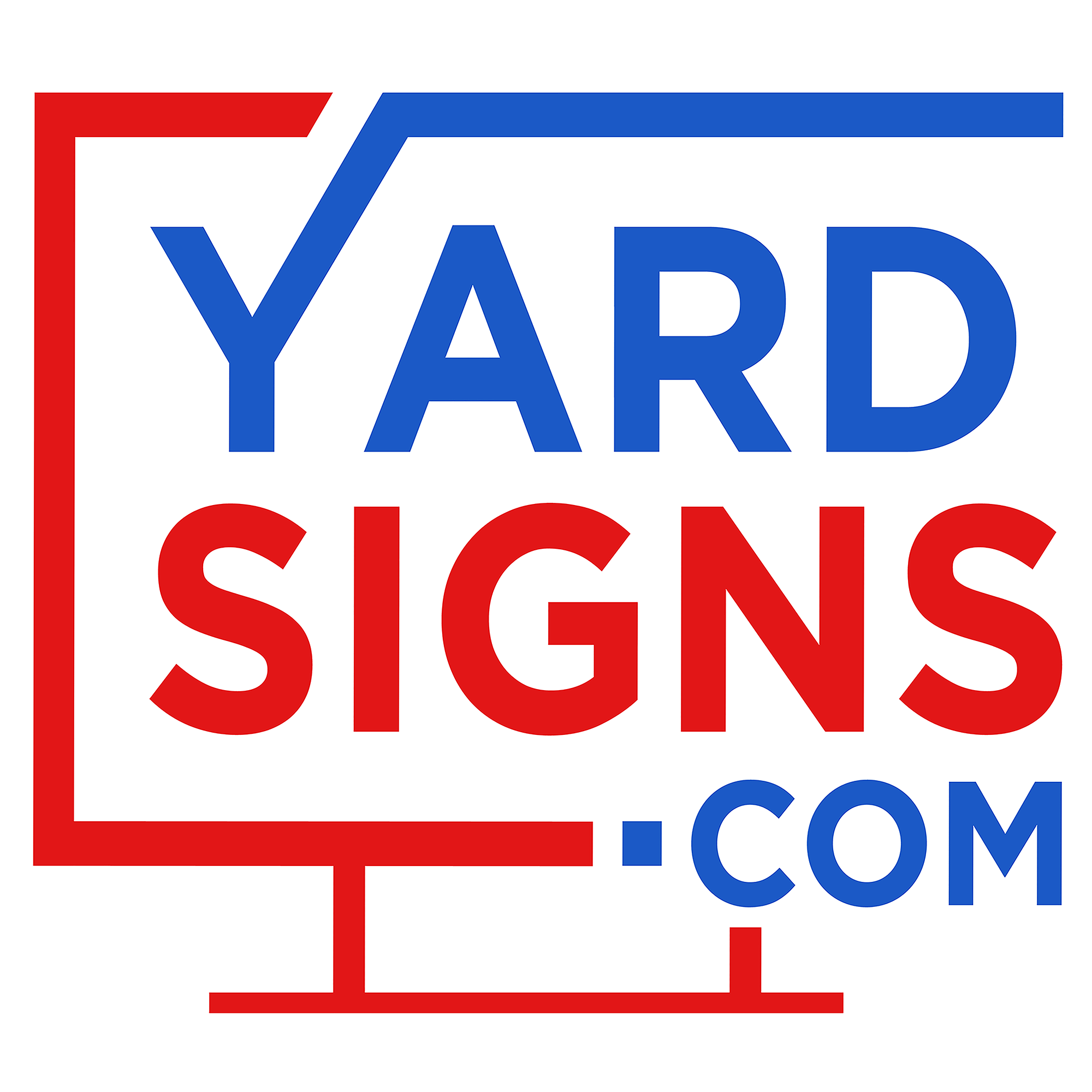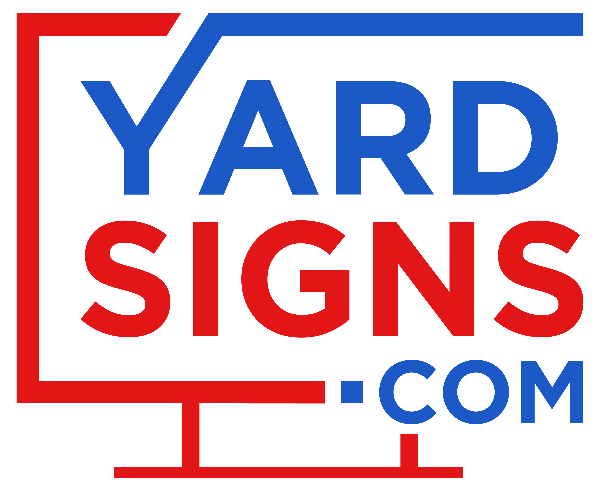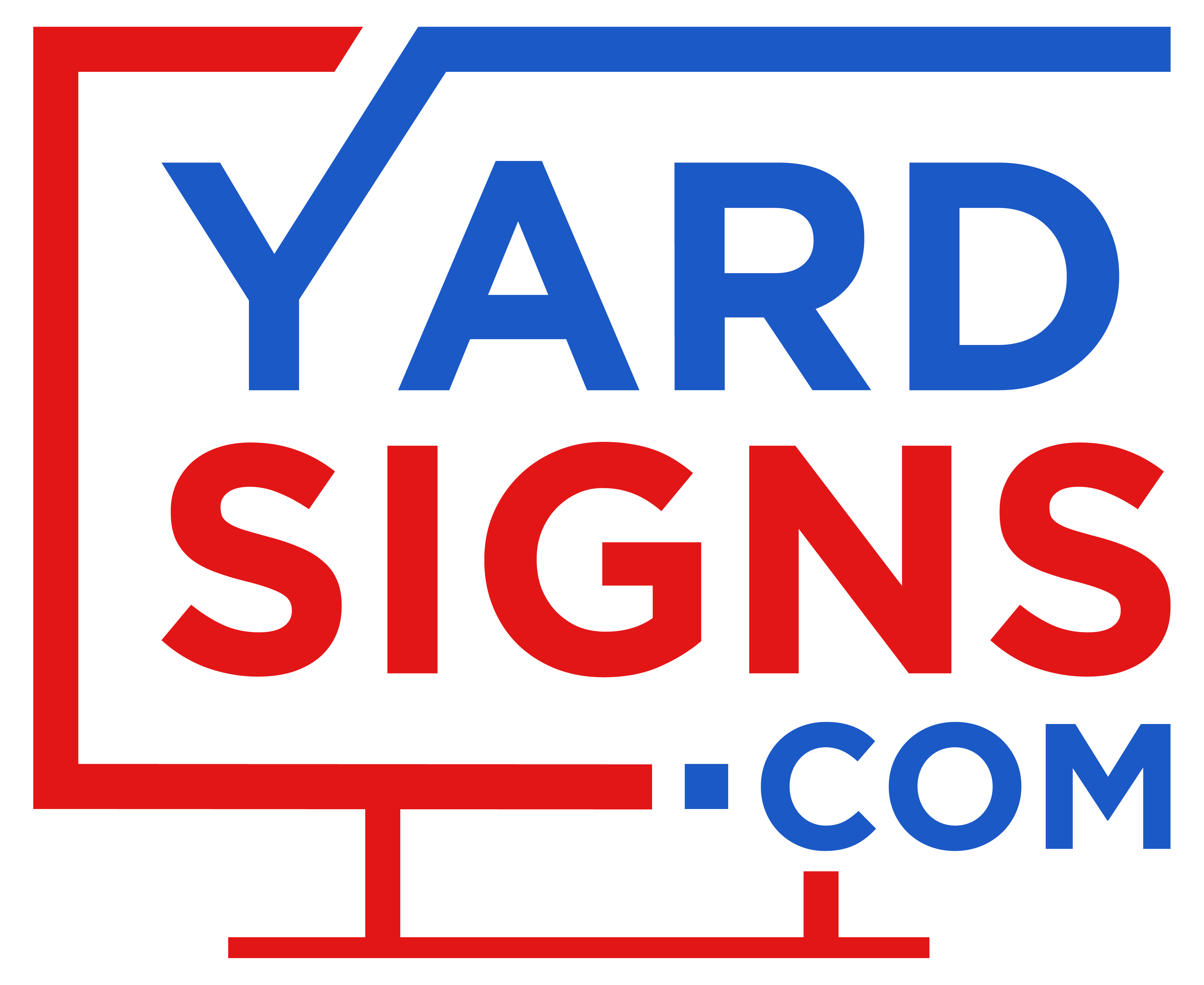Yard signs have been used for decades to promote local services, advertise homes for sale, and support candidates during elections. In 2025, their role in marketing continues, especially in neighborhoods and communities where local visibility matters.
This article explores the marketing return on investment (ROI) of yard signs based on current trends and data. It looks at how yard signs perform compared to digital ads, how to measure their effectiveness, and how they fit into a modern marketing plan.
The goal is to answer a common question: are yard signs effective marketing? To do that, this analysis focuses on design, placement, and performance metrics that matter in today's advertising landscape.
Why Yard Signs Remain a Strong Local Marketing Tool
Yard signs continue to be effective for local marketing in 2025. When placed in high-traffic neighborhoods, they create regular visibility for businesses, events, and properties. This visibility works through repetition – when people see the same sign during their daily routines, they become more familiar with the brand or message.
Yard signs offer precise geographic targeting by appearing in specific locations where the intended audience lives or travels. This makes them particularly valuable for businesses serving particular neighborhoods or communities.
From a cost perspective, yard signs typically have a lower cost per impression than many digital advertising methods. A single yard sign can be seen hundreds of times over its lifespan, spreading the initial investment across many viewings.
Signs in residential or commercial areas also demonstrate that a business is active in the community. This physical presence in neighborhoods supports brand recognition and signals reliability to potential customers.
- Local targeting: Yard signs reach specific geographic areas with precision
- Cost efficiency: Lower cost-per-impression than many digital alternatives
- Trust building: Physical presence creates legitimacy in the community
- Repeated exposure: Daily commuters see the message multiple times
How to Design an Effective Yard Sign for Maximum Impact
The design of a yard sign directly affects how well it communicates its message. Effective yard signs balance visibility, readability, and simplicity to capture attention quickly.
Choose High-Contrast Colors
High-contrast color combinations make yard signs more readable from a distance. This visibility factor is crucial since most people will see the sign while moving past it.

- Black text on yellow background
- White text on blue background
- Red text on white background
Weather conditions affect visibility too. In bright sunlight, darker backgrounds with light text stand out better. For cloudy days or shaded areas, bold, saturated colors work best.
Keep the Message Short and Clear
Brief messages are more effective for yard signs because viewers typically have only seconds to read them. The rule of thumb is to use no more than 7-10 words total.
Examples of effective yard sign messages:
- “Lawn Care Special – Call Today!”
- “Open House – Sunday 2-4pm”
- “Roof Repair – Free Estimates”
Avoiding unnecessary words helps ensure the core message is understood quickly, even by someone driving past at 30 mph.
Incorporate a Strong Call to Action
A call to action (CTA) tells viewers exactly what to do next. Without a clear CTA, even an eye-catching sign might fail to generate response.
Effective CTAs use action verbs and create urgency:
- “Call Now”
- “Visit Today”
- “Scan for Discount”
For service businesses, CTAs like “Book Your Free Quote!” work well. Real estate signs often use “Tour This Home Today!” to encourage immediate action.
Select Readable Font Sizes
Font size determines how far away your sign can be read. The general rule is that 1 inch of letter height equals approximately 10 feet of readability. This means 5-inch letters can be read from about 50 feet away.

Bold, sans-serif fonts like Arial or Helvetica are easier to read from a distance than decorative or script fonts. Fancy fonts might look nice up close but become illegible from the road.
Where and When to Place Yard Signs for Visibility
Strategic placement dramatically affects how many people see a yard sign. The concept of “impression frequency” – how often someone sees your sign – is key to effectiveness.
Target High-Traffic Areas
The best locations for yard signs are places where many people pass by regularly:
- Busy intersections where cars stop or slow down
- Neighborhood entrances and exits
- Near schools and community centers
- Along main commuter routes
- Outside event venues during peak times
These high-traffic areas increase the number of impressions your sign receives each day, making the most of your investment.
Avoid Obstructions and Follow Regulations
A yard sign hidden behind trees or placed too far from the road won't be effective. Similarly, signs that violate local regulations risk being removed.
Most municipalities have rules about:
- How close signs can be to roadways
- Whether signs can be placed in medians
- How long temporary signs can remain in place
- Size restrictions for residential areas
Researching these rules before placing signs helps avoid wasted investment and potential fines.
Rotate Signs to Prevent Fatigue
People stop noticing things they see in the same place day after day – a phenomenon called “advertising blindness.” Rotating sign locations keeps your message fresh and noticeable.
In high-traffic areas, moving signs every 2-4 weeks helps maintain visibility. For less busy locations, rotation every 4-6 weeks is often sufficient.
Track Seasonal and Event Opportunities
Timing yard sign placement with seasonal needs or local events increases relevance and response:
- Landscaping signs work best in spring
- Roofing and exterior painting signs perform well in summer
- HVAC service signs are noticed more before extreme weather
- Event signs placed 1-2 weeks before the event date
This strategic timing connects your message with current needs or interests.
Measuring Return on Investment for Yard Signs
Understanding whether yard signs are worth the investment requires tracking their performance. The basic ROI formula for yard signs is:
(Revenue from yard sign leads – Cost of yard signs) ÷ Cost of yard signs = ROI
For example, if you spend $300 on signs and generate $1,800 in revenue from those signs, your ROI would be 500% ($1,800 - $300 = $1,500, then $1,500 ÷ $300 = 5, or 500%).
Set Clear Goals and KPIs
Before measuring success, define what you want your yard signs to accomplish:
- Lead generation: Counting calls, texts, or website visits
- Brand awareness: Measuring local recognition
- Event attendance: Tracking participation numbers
Common key performance indicators (KPIs) include number of leads, cost per lead, and conversion rate from lead to customer.
Use Tracking Methods
Modern yard signs can incorporate tracking elements to measure response:
- QR codes linking to specific landing pages
- Unique phone numbers for each sign campaign
- Special offer codes mentioned only on signs
These tracking methods connect offline advertising to measurable online or phone responses.
Compare Leads to Ad Spend
Calculating cost per lead helps determine if yard signs are cost-effective:
If you spend $300 on 30 yard signs and generate 15 leads, your cost per lead is $20 ($300 ÷ 15 = $20).
This figure can be compared to other marketing channels to evaluate relative performance. For many local service businesses, a $20 cost per lead would be considered very good.
Assess Long-Term Brand Impact
Beyond immediate leads, yard signs build brand awareness over time. This can be measured by:
- Asking new customers how they heard about your business
- Tracking increases in direct website visits
- Monitoring growth in branded search queries
- These indicators help capture the full value of yard sign marketing beyond just immediate responses.
Comparing Yard Signs to Digital Advertising
|
Marketing Method |
Average Cost |
Targeting Ability |
Duration of Exposure |
Trust Factor |
Best Use Cases |
|
Yard Signs |
Low |
Local/Geographic |
Weeks/Months |
High |
Local services, events, real estate |
|
Social Media Ads |
Medium |
Demographic/Interest |
Days/Weeks |
Medium |
Brand awareness, promotions |
|
Google Ads |
High |
Keyword/Geographic |
Instant/Short-term |
Medium |
Lead generation, search intent |
|
Direct Mail |
Medium-High |
Address/Geographic |
Days |
Medium |
Promotions, coupons, announcements |
Just as digital and physical marketing work best together, combining different types of outdoor signage creates a comprehensive local presence. Yard signs can be the foundation of your outdoor advertising, supplemented by other formats that reach customers at different touchpoints. Advance your marketing strategy with these 7 outdoor signage ideas for small businesses.
Yard signs excel at local brand visibility and community presence. They have staying power – remaining visible for weeks or months – and often carry higher trust because they represent a physical presence in the neighborhood.
Digital advertising offers advantages in targeting specific demographics or interests, and can be adjusted quickly based on performance. However, digital ads typically have shorter visibility periods and may not build the same level of local trust.
The most effective approach for many local businesses is combining both physical and digital marketing channels to reinforce messages across multiple touchpoints.
How to Integrate Yard Signs with Online Campaigns
Modern marketing works best when physical and digital channels support each other. This integrated approach, sometimes called “omnichannel marketing,” creates multiple opportunities for customers to notice and respond to your message.
Add Social Media Handles or URLs
Adding digital contact points to physical yard signs bridges offline and online marketing:
- Use short, memorable URLs (YourBiz.com/Special)
- Include social media handles (@YourBusiness)
- Keep digital information concise and readable
These digital connections make it easy for interested viewers to learn more after seeing your sign.
Generate Leads with Special Discount Codes
Creating unique promotional codes for yard sign campaigns helps track their effectiveness:
- “Use code YARD10 for 10% off”
- “Mention 'SIGN' for free consultation”
- “Enter SPRING23 at checkout”
These codes can be tracked in your sales or booking system to measure direct response from yard signs.
Coordinate Timing with Digital Promotions
Aligning yard signs with your digital marketing creates a consistent message across channels:
- Launch yard signs and social media ads with matching messages
- Send email campaigns that reference the yard sign offer
- Post photos of your signs in real locations on social media
This coordination reinforces your message and increases the chances of response.
Moving Forward with High-Impact Yard Sign Strategies
Yard signs remain a cost-effective, high-visibility tool for local marketing in 2025. Their effectiveness comes from strategic design, thoughtful placement, and integration with digital campaigns.
The most successful yard sign campaigns focus on:
- Clear, readable design with high-contrast colors
- Brief messages with strong calls to action
- Strategic placement in high-traffic areas
- Rotation to maintain visibility
- Tracking methods to measure response
When combined with complementary digital marketing efforts, yard signs help build a strong local presence that drives awareness and leads.
Future trends in yard sign marketing include eco-friendly materials, enhanced tracking through QR codes, and data-driven placement strategies based on traffic patterns and response rates.
Ready to boost your local presence? Scan the QR Code to place an order for your custom yard sign today at Yardsigns.com and start building your local presence with high-quality, attention-grabbing designs delivered right to your door.
Frequently Asked Questions About Yard Sign Marketing
Are eco-friendly yard sign materials durable enough for outdoor use?
Most eco-friendly yard sign materials now offer comparable durability to traditional plastics, with many lasting 3-6 months in normal weather conditions.
How often should yard signs be replaced to maintain effectiveness?
Replace yard signs every 2-3 months or whenever they show visible weather damage to maintain professional appearance and readability.
What size yard sign provides the best visibility for the cost?
The standard 18”x24” yard sign size offers excellent visibility from roads while remaining cost-effective for most local marketing campaigns.
How can service businesses track leads from yard sign marketing?
Service businesses can track yard sign effectiveness by using unique phone numbers, QR codes, or special offer codes that are exclusive to their sign campaigns.
************
About the Author
Bryan Croft is the CEO of HC Brands and a passionate entrepreneur with more than 27 years of experience in the e-commerce space. He’s spent nearly three decades building, growing, and evolving online businesses, with a core belief that great brands are built through innovation, consistency, and a deep understanding of the customer. Under Bryan’s leadership, HC Brands has expanded into a family of successful websites including YardSigns.com, SimplyStamps.com, and many more showcased at HCBrands.com/all-brands. Each site is designed to bring value, customization, and efficiency to both consumers and businesses across a wide range of industries.
From the early days of the internet to today’s dynamic digital landscape, Bryan has witnessed—and helped shape—the evolution of online retail. What sets him apart isn’t just longevity; it’s his hands-on approach, his willingness to adapt, and his ability to lead through change. Whether it's navigating new marketing trends, optimizing operational systems, or guiding a team through turbulent times, Bryan brings a steady hand, a clear vision, and an entrepreneurial mindset to everything he does.
Beyond business, Bryan believes deeply in giving back and staying engaged with the community. He is the past president of the International Marking Device Association, where he worked closely with peers to advance innovation and collaboration in the marking industry. Locally, he served as president of the Atlantic Beach Country Club, helping to foster both leadership and fellowship in his hometown community.
His heart for service extends further, too. Bryan volunteers with the Boys & Girls Clubs of Northeast Florida, supporting youth development and leadership programs that provide meaningful opportunities to the next generation. He has also traveled to Haiti on mission trips with Haiti180.com, a nonprofit organization dedicated to helping orphans, the elderly, and underserved communities through hands-on service and support. These experiences have left a lasting impact on his worldview and leadership style, reminding him that the best work often happens far beyond the walls of the office.
On a personal level, Bryan is first and foremost a proud dad to three incredible kids. Family is at the center of everything he does. Whether it’s mentoring them through life and business or sharing simple moments together, being a father is one of his greatest joys. He also enjoys playing golf (especially on early mornings with a solid cup of coffee in hand) and is happiest when he’s catching a sunrise on the shores of Neptune Beach, Florida, where he lives with his family.
Bryan’s blog posts are a reflection of his journey—equal parts business strategy, life lessons, and personal perspective. His goal is to help other leaders, entrepreneurs, and creatives navigate the intersection of business and purpose, while staying grounded in what really matters. Whether you're a seasoned pro or just starting out, you'll find his insights honest, approachable, and rooted in experience.
Contact Bryan on LinkedIn: https://www.linkedin.com/in/bryancroft/




